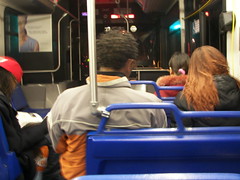Try it, you might not like it, but you don't know til you try.

On the G8.
Jaime of Stop, Blog and Roll must get to read the Examiner before I do, because she pointed me to today's column by Steve Eldridge about suburban attitudes toward (bus) transit, in the piece "Stereotypes keep many off the bus." Alas he doesn't say anything that people who do transit marketing don't already know.
People fear the unfamiliar. And they make up reasons to justify their fears.
Loser cruisers indeed.
In the U.S., with less than 10% of the population riding transit (NYC and Chicago make up 40% of all transit riders), and with the prevalence of teen driving, and even children being driven to school, most Americans grow up with limited experience riding transit.
This problem is compounded by the fact that people who do transit marketing tend to not be very creative.

Pittsburgh, Boulder, and Orlando are some of the communities that do some creative bus-transit marketing. The bus pictured is in Pittsburgh.
Kids need to do field trips on buses, transit systems need to sponsor and be at street festivals, etc.
People need to be exposed to transit to be comfortable with it. In most center cities, there isn't a separate school bus systems, students ride public transit if they can't walk to school. As a result, they become familiar with getting around by bus (and subway).
I never rode a public transit bus when I lived in the suburbs of Detroit. I can't remember if I did when I lived in Detroit when young. I do remember walking to school (that was not the era when children were driven to school!) and rode a bike sometimes. Mostly we walked.
In Ann Arbor, I mostly walked or drove. There was a period when I did ride either University buses or the Ann Arbor Transportation Authority buses. But it wasn't a long period. I lived within walking distance to most places I wanted to go.
It wasn't until I came to DC that I started riding transit much more regularly, and not just subway. I happened to have lived in areas with efficient bus service, so I ride buses not infrequently, although I rely on my bicycle.
Anyway, there are many places where transit can be promoted besides street festivals--at schools, in office buildings, at subway stations, at shopping malls, at movie theaters, etc.--but it takes a fundamental rethinking of how to promote transit.
I learn from my conversations with various people responsible for this that they aren't thinking about this enough. And ideas obvious to me aren't obvious to them. For example, the new bicycle map should be put up on boards comparable to the bus maps, and installed in subway stations.


This is really a mouse pad, but you know what these maps look like as they have been rolled out throughout the WMATA system to Metro Stations by Toni Byrd and her crew.
I have learned that my idea of the transitshed (also called the mobilityshed) is semi-unique, or at the very least my professor hasn't heard of the concept, and he's familiar with a fair amount of the literature. However, Robert Cervero (at UC Berkeley) does use the term "commutershed" to refer to the broad catchment area for commuting from home to office, and it has definitely similarities to the idea.
But the idea of the transitshed/mobilityshed is to link various modes in a more systematic manner to promote mode shift away from Single Occupancy Vehicle trips. The intent is to link transportation planning with marketing in a more direct fashion.
Steve can start by organizing a bus trip outing with his friend's family. This is a situation where "Each One, Reach One, Teach One" is the necessary course of action.
A person I know moved to DC from the west coast and gave up her car, she rides bus and subway (taking advantage of her work's transit benefits program) and she now saves $600/month. .... (See What is Metrochek?)
Labels: transit, transportation planning



0 Comments:
Post a Comment
<< Home